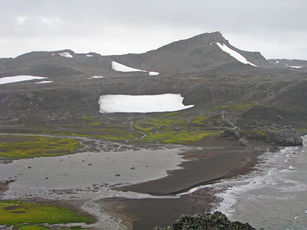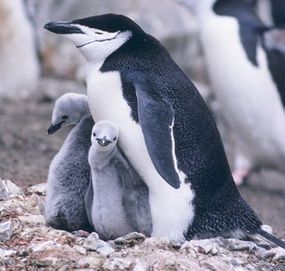Ecoregions of Antarctica
Ecoregions of Countries Collection 
Although Antarctica,the coldest, driest, windiest, and, on average, highest and most isolated, continent on Earth, has a vast landmass, there are only two recognized ecoregions.
Antarctica covers almost one tenth of the Earth's terrestrial surface, or 13.9 million square kilometers. However, 98% of this area is covered by a permanent ice sheet, that contains 90% of the world’s ice and almost 70% of the Earth’s freshwater. The remaining two percent of land area, restricted primarily to the coastal fringes of the continent, is where the majority of Antarctica’s limited terrestrial life exists.
Ice-free Antarctica can be roughly divided into two biogeographic regions: Marielandia (East), including the Antarctic Peninsula, and the continental coast, or Maudlandia (West).
The Transantarctic Mountains extend 3,200 km dividing the continent into East (Maudlandia) and West (Marielandia).

Source: World Wildlife Fund. 2000. Global 200 Ecoregions.
It is interesting to compare Antarctica’s ecosystem with that of the Arctic region: Antarctica has more available liquid water, and hence tundra has slightly higher biomass and primary production rates. However, the isolation of Antarctica has led to quite different assemblage of species. About 900 vascular plants are native in the Arctic, while there are only two in Antarctica. The Arctic has 48 species of native land mammals; Antarctica has none. Among bryophytes and lichens there are a few cosmopolitan species, and a definite bipolar element exists, especially in the case of lichens. Explanations for this might be long-distance transport of propagules via mountaintops across the tropics, or possibly survival of species from the time when Gondwanaland was still linked to the northern land masses.
The difference in species is also due to Antarctica’s cold, oceanic climate, compared to the Arctic’s continental/sub-alpine climate. In general, Arctic has short, favorable growing seasons, while Antarctica has longer, cool, wetter growing seasons. The absence of terrestrial carnivores allows for the presence of seven species of penguin in Antarctica. These birds are all flightless and nest ashore in large colonies that would be very vulnerable to predators. Three species of seal breed ashore in Antarctica, whereas none do in the Arctic. Their presence has some impact on the flora.
Contents
Maudlandia Antarctic desert
 Don Juan Pond, McMurdo Dry Valleys, site of extremophile micro-organisms. Source: University of Georgia Maudlandia covers a greater area than Marielandia, about two-thirds of the continent. However, the whole of this region is subject to a harsh continental Antarctic climate, which is cold, windy and arid.
Don Juan Pond, McMurdo Dry Valleys, site of extremophile micro-organisms. Source: University of Georgia Maudlandia covers a greater area than Marielandia, about two-thirds of the continent. However, the whole of this region is subject to a harsh continental Antarctic climate, which is cold, windy and arid.
Maudlandia differs from Marielandia in that the larger expanses of ice-free land are found inland, rather than near the coast. It is within the McMurdo Dry Valleys that the most noteworthy examples of extremophile species adapted to the harsh climate occur. In this landscape that was once assumed to be completely barren, microbiologists in the 1970s discovered communities of microscopic algae, fungi, and bacteria living protected inside rocks. These organisms live in minute gaps between grains of sandstone, close to the surface of the semi-translucent rock where they can receive some sunlight (Solar radiation) and moisture, and also receive nourishment from the minerals in the stone. These organisms are known as cryptoendolithic microorganisms.
A notable example of the environment that fosters such extremophile organisms is Don Juan Pond in the McMurdo Dry Valleys. This hypersaline lake has been researched for several decades due to the unusual lifeforms, although ongoing research is limited by the constrained access and strict seasonality of research.
Marielandia Antarctic tundra
 Coastal estuary on King George Island; Antarctic fur seals are visible on the shore. @ C.Michael Hogan This ecoregion includes the [[coast]al fringes] of the Antarctic Peninsula, which are free of permanent ice. Stretching north towards the southern tip of South America, this area is the portion of Antarctica closest to another continent.
Coastal estuary on King George Island; Antarctic fur seals are visible on the shore. @ C.Michael Hogan This ecoregion includes the [[coast]al fringes] of the Antarctic Peninsula, which are free of permanent ice. Stretching north towards the southern tip of South America, this area is the portion of Antarctica closest to another continent.
The scattered ice-free areas of the Antarctic Peninsula and West Antarctica west of the Transantarctic Mountains are characterized by low temperatures, high aridity, and a short growing season. Cryptograms—mosses and lichens—dominate the vegetation of the Antarctic tundra.
The discovery of Fossil plants, reptiles, and marsupials of the same species as those found in other parts of the Southern Hemisphere indicates that Antarctica was once joined to the other continents and that its climate was once temperate.
The Antarctic Peninsula, or Marielandia, currently has the mildest climate on the continent. It is here that Antarctica’s only two vascular plants grow, and it is here that such wildlife as penguins, flying seabirds, and seals are most plentiful
Fauna
 Adult chinstrap penguin with chicks. Source: NOAA As all larger animals of the terrestrial ecosystem of Antarctica obtain their food from the productive waters of the Southern Ocean, it is the [[coast]al areas] of Maudlandia that are populated with large colonies of birds and seals. The characteristic animal of Antarctica, the flightless penguin, can exist in the southern polar regions only due to a lack of any significant predators.
Adult chinstrap penguin with chicks. Source: NOAA As all larger animals of the terrestrial ecosystem of Antarctica obtain their food from the productive waters of the Southern Ocean, it is the [[coast]al areas] of Maudlandia that are populated with large colonies of birds and seals. The characteristic animal of Antarctica, the flightless penguin, can exist in the southern polar regions only due to a lack of any significant predators.
In the Arctic, penguins would be far too vulnerable to such carnivores as polar bear and Arctic fox. Leopard seals are important penguin predators. Of the estimated total of 350 million birds of all species in the Antarctic, about 175 million are penguins, and the rest are flying birds.
Six species of penguin are considered native to the Antarctic region: Adélie penguin (Pygoscelis adeliae), chinstrap penguin (P. antarctica), gentoo penguin (P. papua), emperor penguin (Aptenodytes forsteri), king penguin (A. patagonicus), rockhopper penguin (Eudyptes crestatus), and macaroni penguin (E. chrysolophus). Four of these breed on the continent: the Adélie, emperor, chinstrap, and gentoo penguins. Adélie penguins are by far the most plentiful penguin species on the continent.
Current Status
The Antarctic Treaty was signed in 1959 and now holds signatures of 44 nations. The treaty applies to the area south of 60° south latitude, including all islands and ice shelves. It includes prohibitions on the killing, wounding, capturing or molesting of any native mammal or native bird—except in accordance with a permit—as well as regulations on the importation of exotic species, parasites, and diseases. Permits may only be issued by persons authorized by a participating government. Also, numerous conservation areas are designated in several categories, and carry further regulations. For example, vehicles are prohibited to enter Specially Protected Areas.
The Antarctic Treaty has, for the time being, put a ban on any Antarctic nuclear testing, radioactive waste disposal, and oil or other mineral drilling. It does not, however, prevent environmental degradation altogether. Much of the Antarctic ecosystem, particularly its flora, is extremely vulnerable to even slight disturbancs. Several thousand researchers and tourists visit the continent each year. While the majority of tourism is concentrated at the more accessible Antarctic Peninsula, it is a growing industry on the continental portion, corresponding with the rising interest in adventure tours. Ship-based tours visit McMurdo Sound in the Ross Sea, viewing historic huts and scientific research stations. Helicopter tours to the Dry Valleys are part of one tour-operator’s itinerary. A few studies have been done on the impact of human disturbance in Antarctica. It was found that the nesting pairs of Adélie penguins in a rookery close to McMurdo Station dropped by half after the station was established and disturbance by humans and helicopters began. The rookery has partially recuperated since more protective measures were put in place.
Context
Ecoregions are areas that:
[1] Share a large majority of their species and ecological dynamics;
[2] Share similar environmental conditions; and,
[3] Interact ecologically in ways that are critical for their long-term persistence.
Scientists at the World Wildlife Fund (WWF), have established a classification system that divides the world in 867 terrestrial ecoregions, 426 freshwater ecoregions and 229 marine ecoregions that reflect the distribution of a broad range of fauna and flora across the entire Earth.
References
- National Science Foundation. 1991. Final Supplemental Environmental Impact Statement (SEIS) on the U.S. Antarctic Program (USAP).
- EPA. 2001. Chapter 2: Affected Environment - the Physical and Biological Environment. Final Environmental Impact Statement for the Proposed Rule on Environmental Impact Assessment of Nongovernmental Activities in Antarctica. Retrieved (2001) from: EPA.
- Fogg, G. E. 1998. The Biology of Polar Habitats. Oxford University Press, New York, N.Y. ISBN: 0198549539
- Headland, R. K. 1996. Protected Areas in the Antarctic Treaty Region. from: Scott Polar Research Institute.
- Parfit, M. 1998. Timeless Valleys of the Antarctic Desert. National Geographic October: 120-135.
- Purvis, W. 2000. Lichens. Smithsonian Institution Press, Washington, D. C. ISBN: 1560988797
- Udvardy, M. D. F. 1975. A classification of the biogeographical provinces of the world. IUCN Occasional Paper No. 18. International Union of Conservation of Nature and Natural Resources, Morges, Switzerland.
- Udvardy, M. D. F. 1987. The Biogeographical Realm Antarctica A Proposal. Journal of the Royal Society of New Zealand 17:187-194.
- Watson, G. E., J. P. Angle, and P. C. Harper. 1975. Birds of the Antarctic and Sub-Antarctic. American Geophysical Union, Washington, D. C. ISBN: 0875901247
